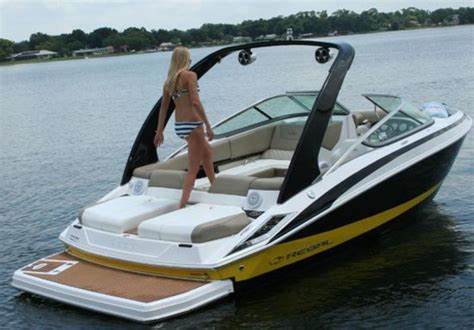Many people considering the purchase of a new boat often ask about the differences between outboard and stern drive (or inboard/outboard) propulsion.
Understanding the pros and cons of each system will help families find the right boat for their situation.
Stern drive propulsion systems basically have a marinized automotive engine inside the boat with an out-drive on the outside of the boat.
These types of drive systems are found mostly in family runabout boats and cruisers because of their user friendly layout.
Outboards are the primary choice for fishing boats and certainly are the most popular choice for boats in the Lowcountry.
Most family boat manufacturers have added outboard power options to their lineups as well, bringing more options to local boaters than just center consoles.
The annual maintenance of outboards is generally less
Now, potential buyers can better choose the boat configuration that meets the family’s needs and match that to their choice of power.
Typically, the initial purchase price of outboard power is greater than stern drives. However, the annual maintenance of outboards is generally less.
Furthermore, stern drive engines will require exhaust manifolds, usually in 5-7 years in a salt water environment. Additionally, stern drive engines require winterization if a hard freeze is expected.
Understand that the purchase price will usually be lower for stern drives, but over time, they will cost more.
Because the engine portion is typically underneath a sun pad on the stern of the boat, stern drives have much better space utilization in the aft. This affords much better access to the water and better lounging.
There is no wasted space with outboard splash wells. Further, there is no engine to interfere with rear visibility. Another benefit of stern drive power is safety.
In most applications, stern drive units are underneath the swim platform, providing better protection from the drive when jumping into the water or swimming around the boat.
As an added benefit, the extra padding around the stern drive engine reduces noise, providing a more comfortable ride in a stern drive boat.
On the other hand, many outboard models offer spacious lazarette storage and manufacturers have designed ways to enhance the swim platform area.
Certainly one of the biggest advantages to outboard power is the fact that outboards can be tilted up to run in very shallow water.
This provides advantages for fishermen who need to get in shallow waters in search of baitfish, or to the homeowner who has to navigate very shallow waters to get into the neighborhood tidal creek.
That is not to say that stern drives cannot be tilted up. In fact, they can be tilted up, even with the keel of the boat in order to get off of a sandbar.
The difference is that since the outboard shaft is connected to the engine, and the entire engine tilts, there is no potential for drive damage. When a stern drive is tilted, the engine remains in position.
The tilt is made possible due to a component known as a universal joint. The engine should be turned off in order to get into the tilt position in order to avoid damage to the universal joint.
As you consider a new boat, take these points into consideration to be sure that you are getting the best configuration and power to fit your needs.
Of course, our Tidewater center consoles are all outboard powered, but Bayliner and Regal both build family boats with your choice of outboard or stern drive power.
Let us help you and your family navigate the many choices available for your next family boat.
Jim Duncan / Duncan’s Boats
www.duncansboats.com
843-744-2628
You may also like to read Choosing the right boat for you





